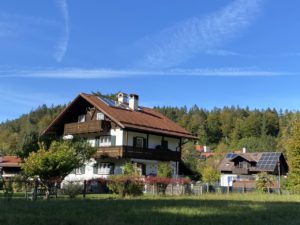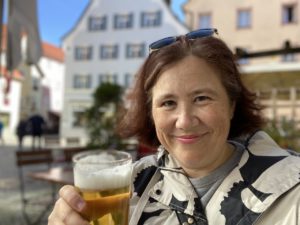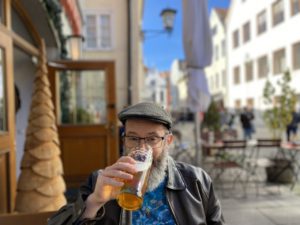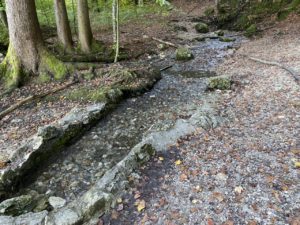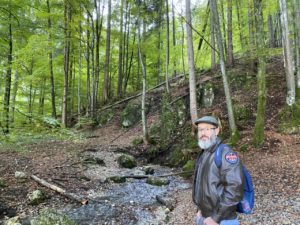On our way back from Barcelona, I pulled out my phone and idly checked the Hohenschangau ticket office, as I had many times over the past few months. To my delight, they actually had some tickets available for the next weekend! On a whim I bought a pair and we quickly arranged a weekend away in Füssen, the nearest town to the famous castle of Neuschwanstein.

Füssen is southwest of Munich, less than three hours on the train. (It’s right next to the Austrian border, the next valley over from Garmisch-Partenkirchen.) The weather that weekend was gorgeous, and it was thrilling to see the mountains rising up in the distance. And… is that a little castle I spy?? 🏰

We stayed in the Hotel Schlosskrone, just a short walk from the train station. The view from our hotel was pretty glorious.
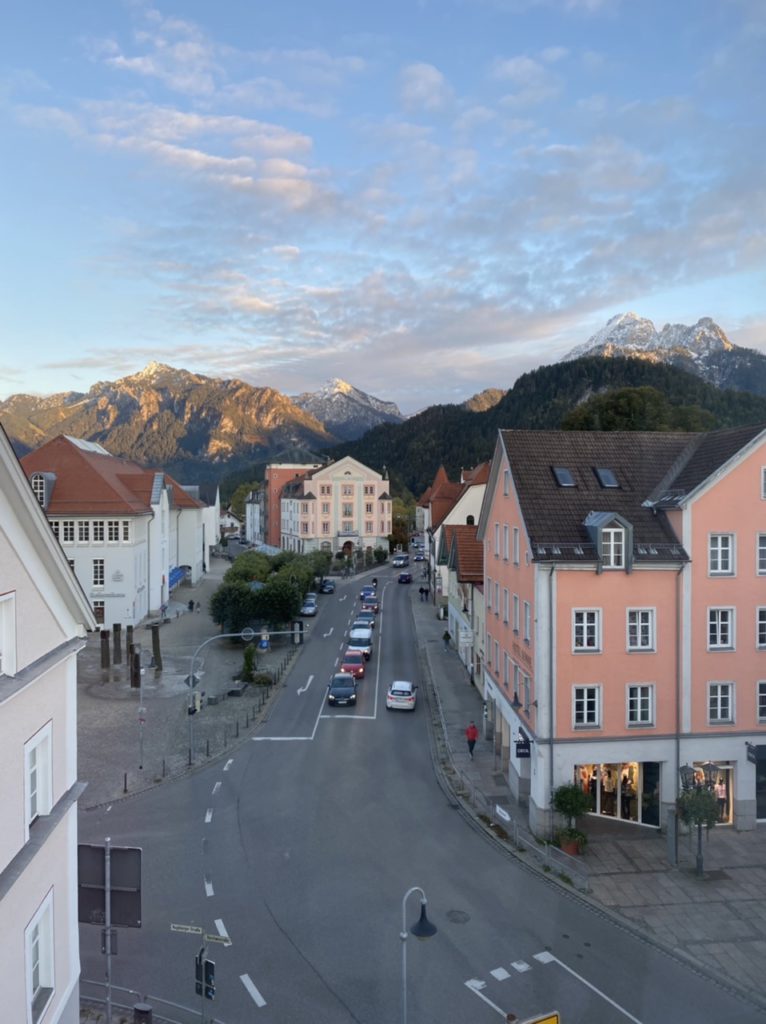
We headed out into the town for a wander and to find some dinner. Füssen was founded in Roman times and it’s retained quite a medieval feel.

It’s pretty touristy too, being the closest place to Ludwig’s castles. Phew, €500+ for a cuckoo clock?!
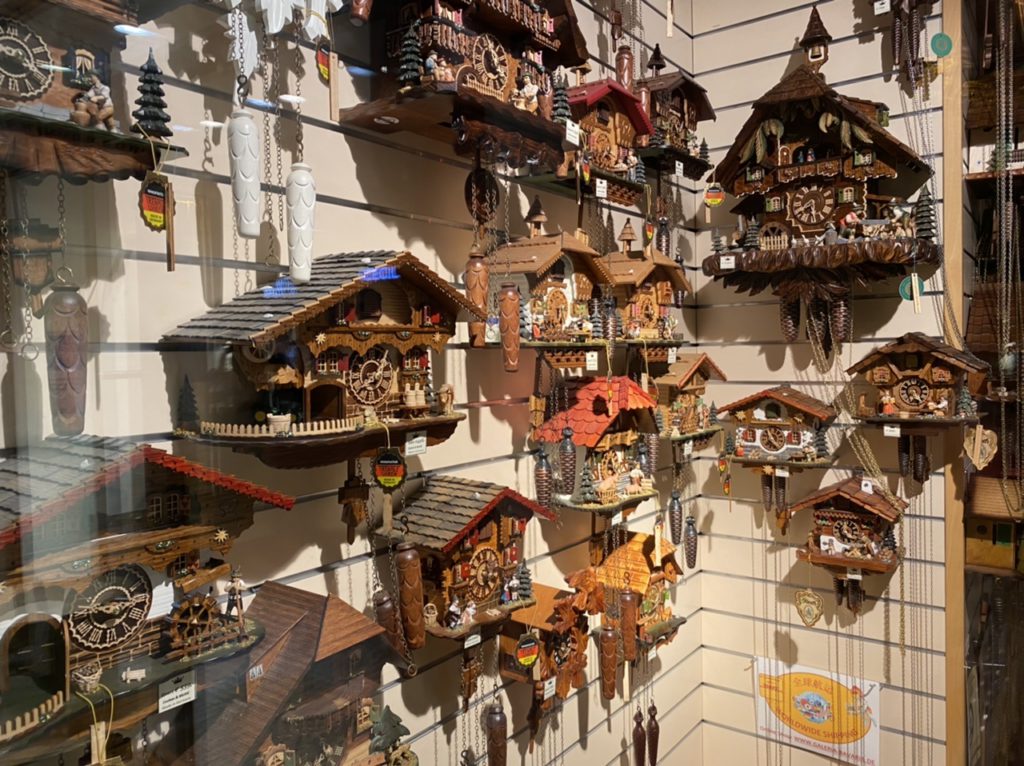
We also got a glimpse of the Hohes Schloss (“High Castle”) up on the hill, the former summer residence of the prince-bishops of Augsburg.
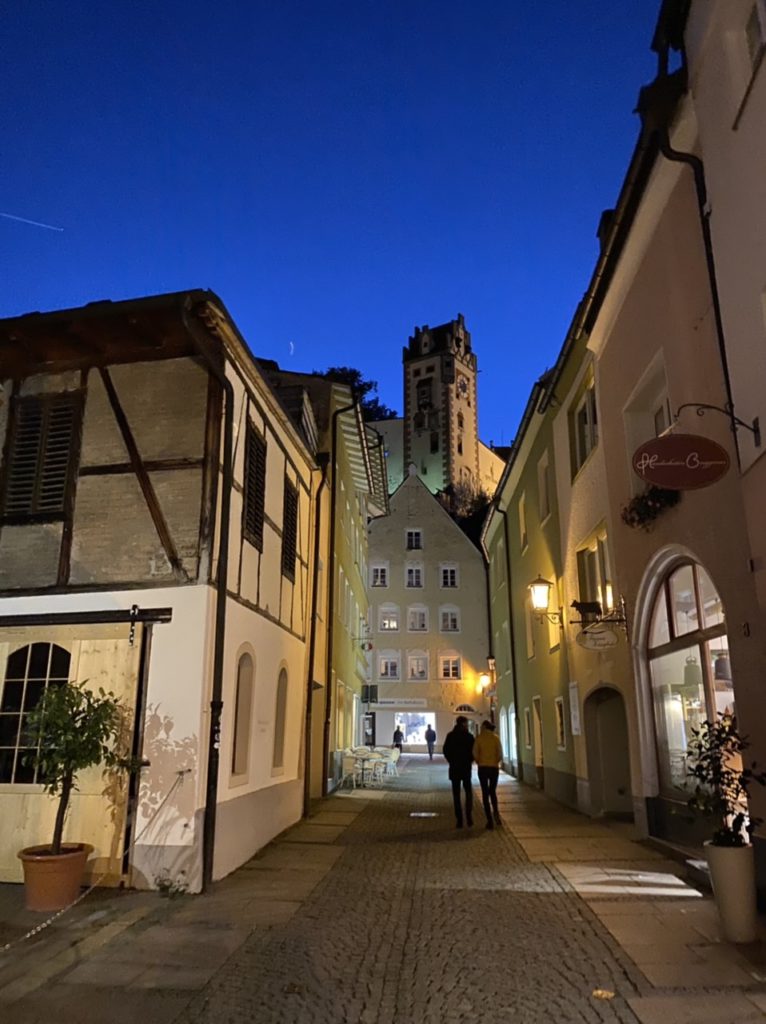
The next day we headed back out to check it out in the sunshine…

Gosh it was beautiful there.
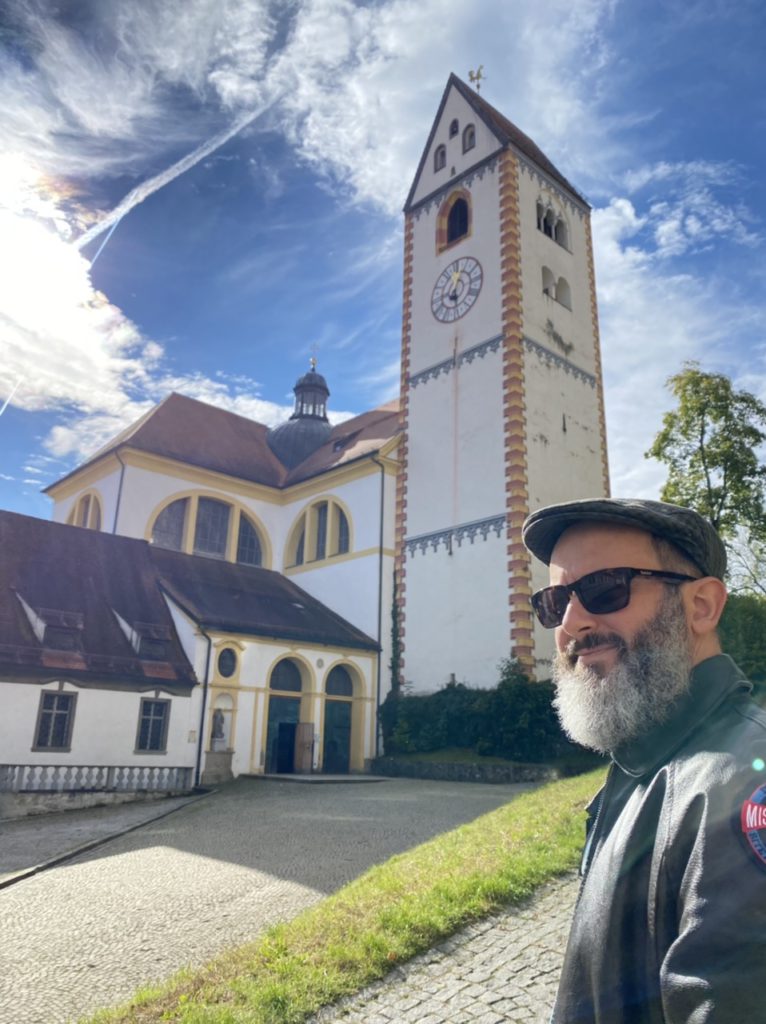
We were heading towards the river, where we knew there were was a waterfall. Along the way we ducked in the courtyard of St. Mang’s, a former Benedictine monastery. Now it contains the Museum of Füssen.
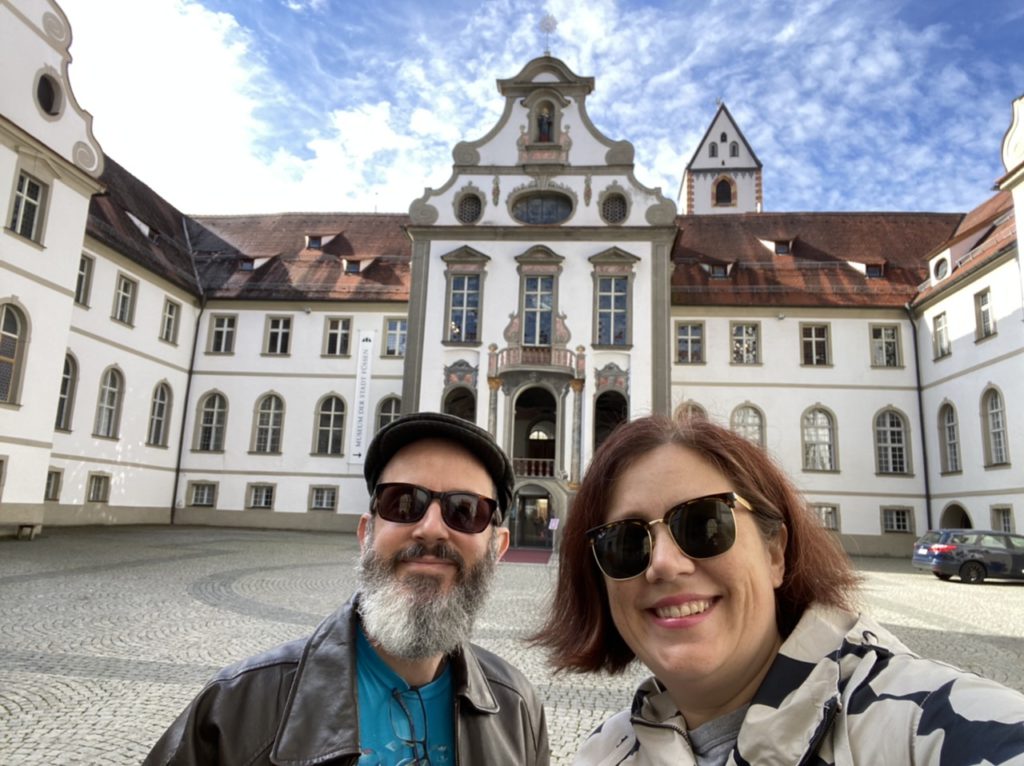
I loved how decorated the buildings were in town. This was the Church of the Holy Spirit.

The river in Füssen is called the Lech, and it flows from a lake in the Alps all the way to the Danube. Here’s the Snook on the Lechbrücke (“Lech Bridge”).

We had another view of St. Mang’s from the river.

We crossed the river and hiked a short distance to the west, where we reached our destination – the Lechfall.

The water pours down a series of steps at a narrow bend in the river with high cliffs on either side. Up on the cliff there is a small memorial to King Maximilian II of Bavaria. There’s also a small footbridge across the river that we headed down to get a better view.

I recorded a little video too.
Behind us, looking back east towards town…
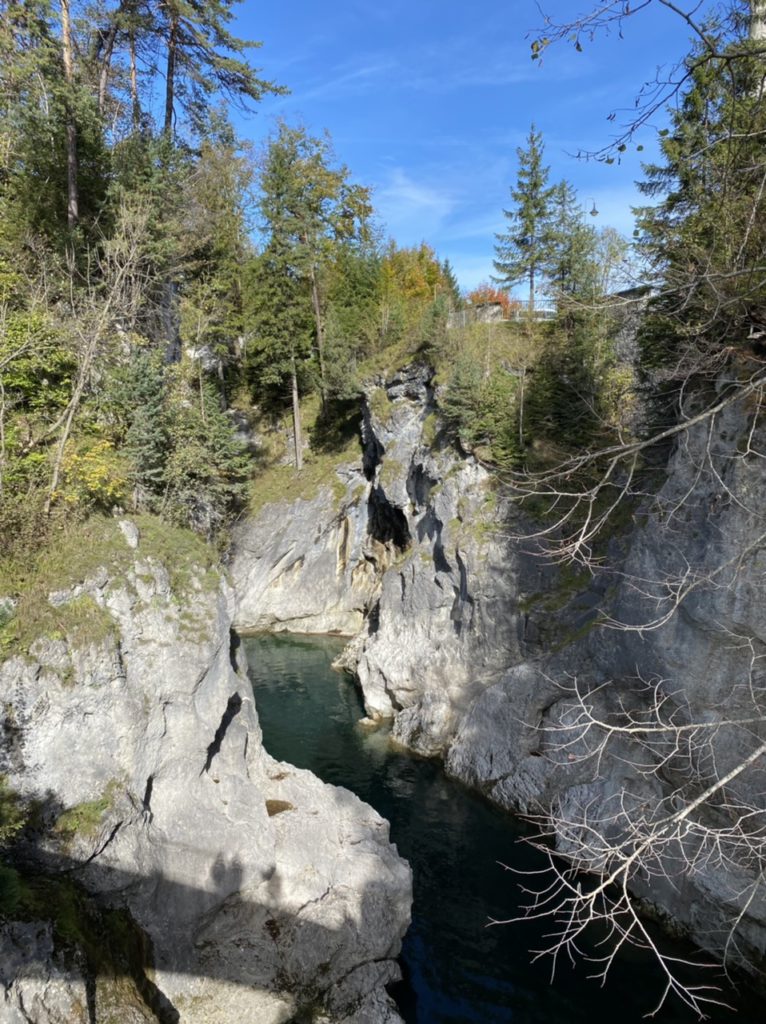
The water in the river was incredibly clear.
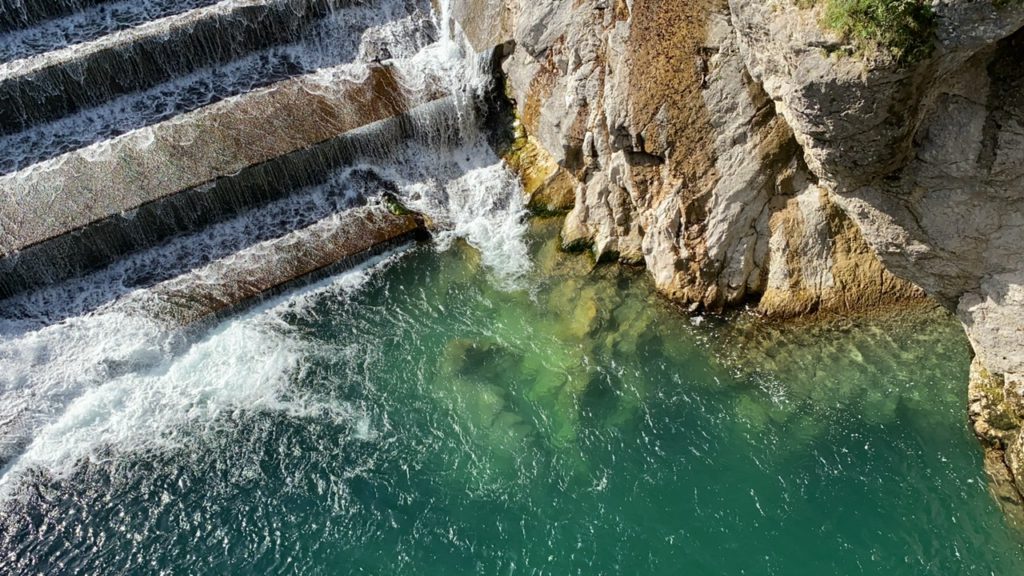
We crossed the river in search of the Via Claudia Augusta, the ancient Roman road created by Drusus and his Emperor son Claudius. Now parts of it are a popular hiking path marked with replicas of the Roman milestones.

We followed it north towards the Tal der Sinne (“Valley of the Senses”).
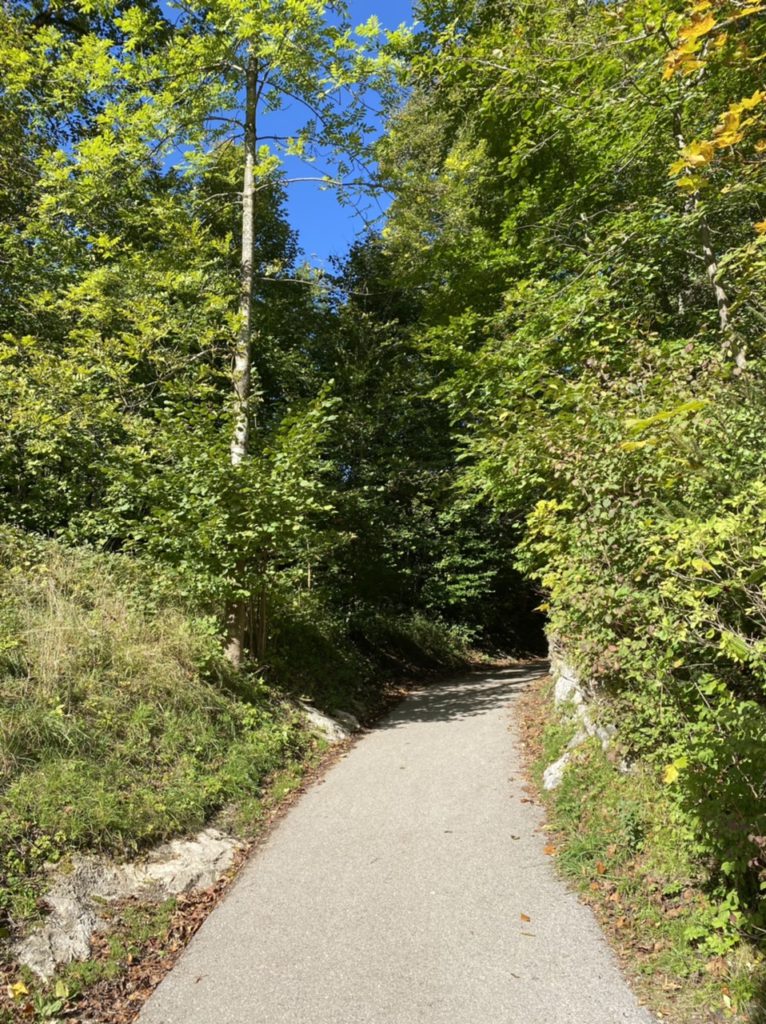
Along the way we passed lots of charming houses, both modern and traditional.
We made it to The Valley and found an old ski jump! That was pretty cool.

And the Snook got to impersonate a sundial.
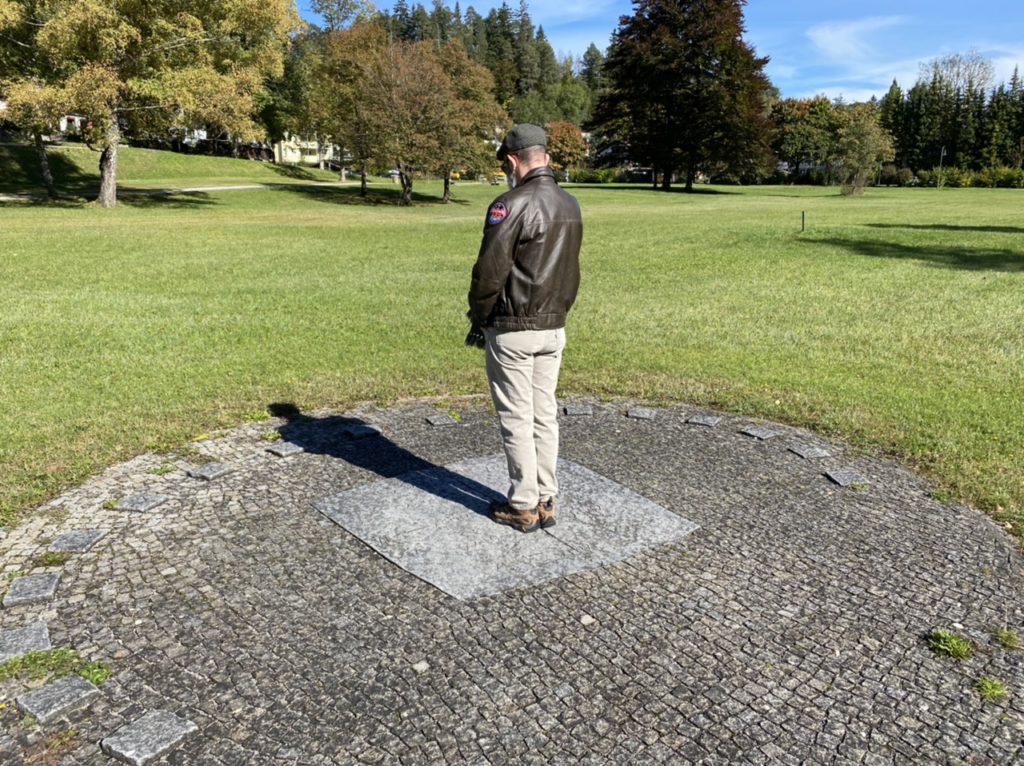
We hiked back into town in search of sustenance. We passed a lot of hotels and guest houses, but tourist numbers were still pretty low due to Covid.
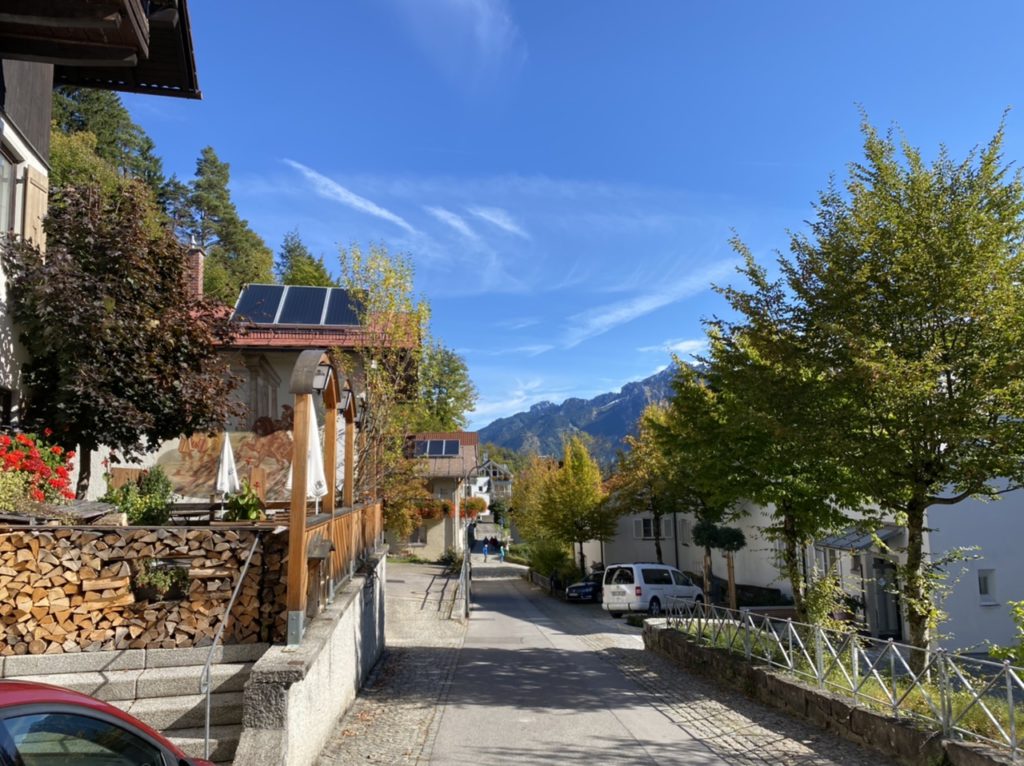
I thought this building covered in birdhouses was really cute.

Back in town, we did some shopping. I lobbied hard, but no, he regrettably did not buy the hat.
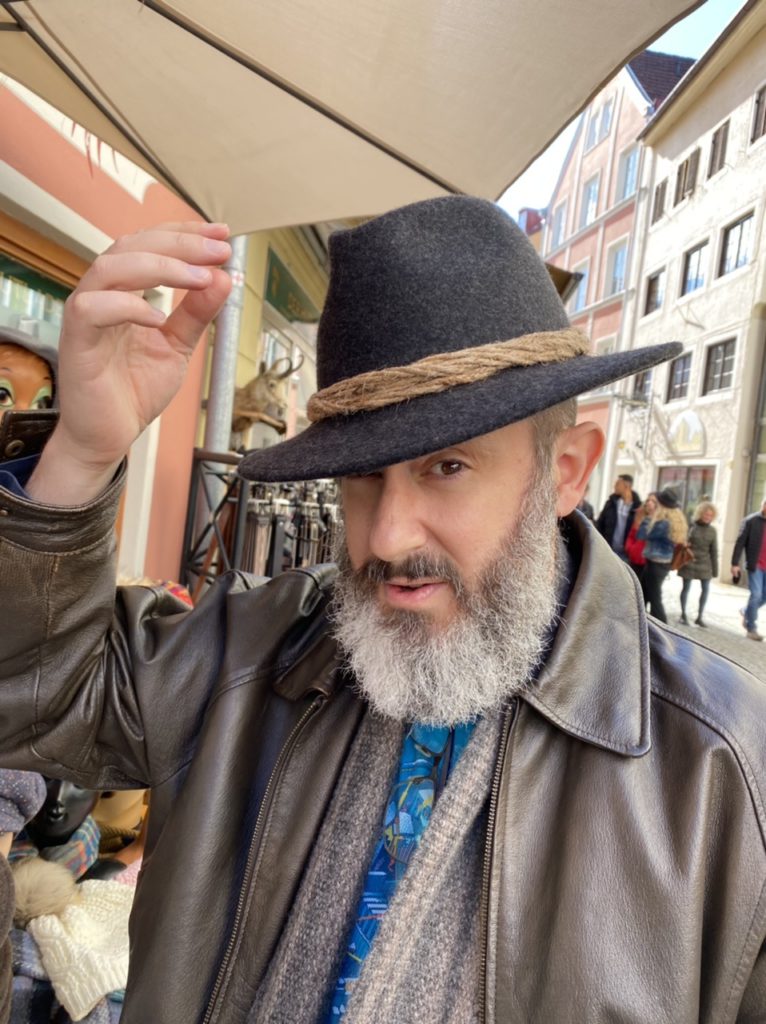
We found a sunny spot for lunch and beers…
The Snook may not have bought a hat, but I did! I got it at the Hutladen.
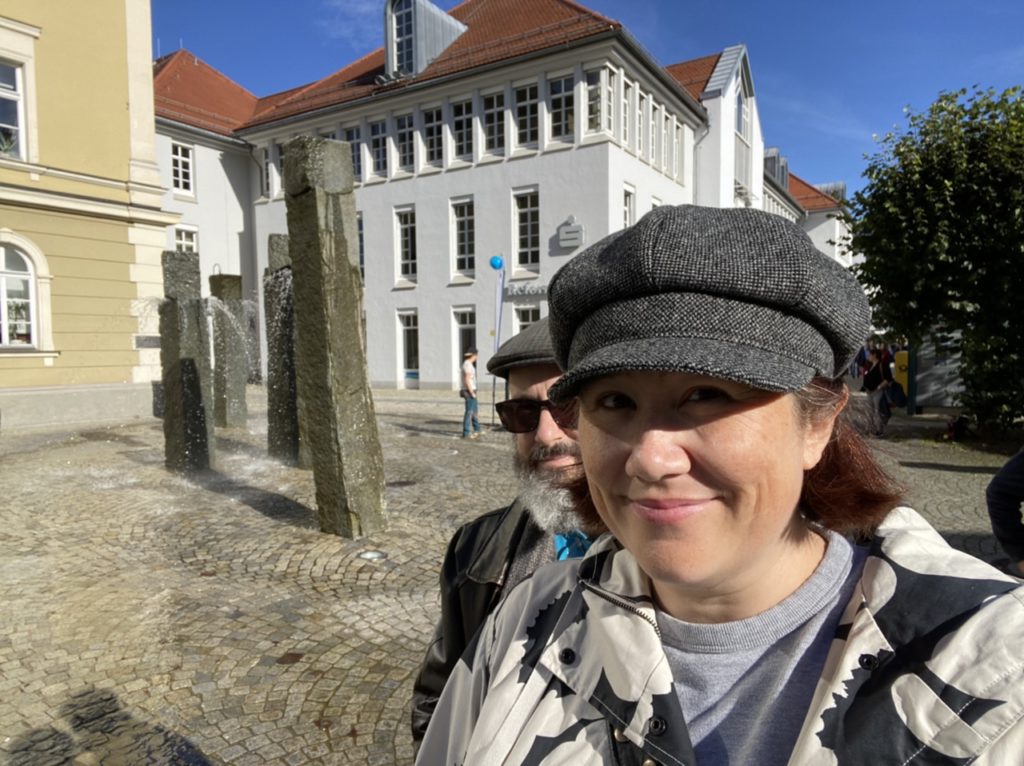
The next day, it was time to head to the castles! 🏰
We got up early and caught a bus from Füssen to Hohenschwangau, just a couple kilometres away. We stepped off the bus and looked up to see Neuschwanstein gleaming above us.
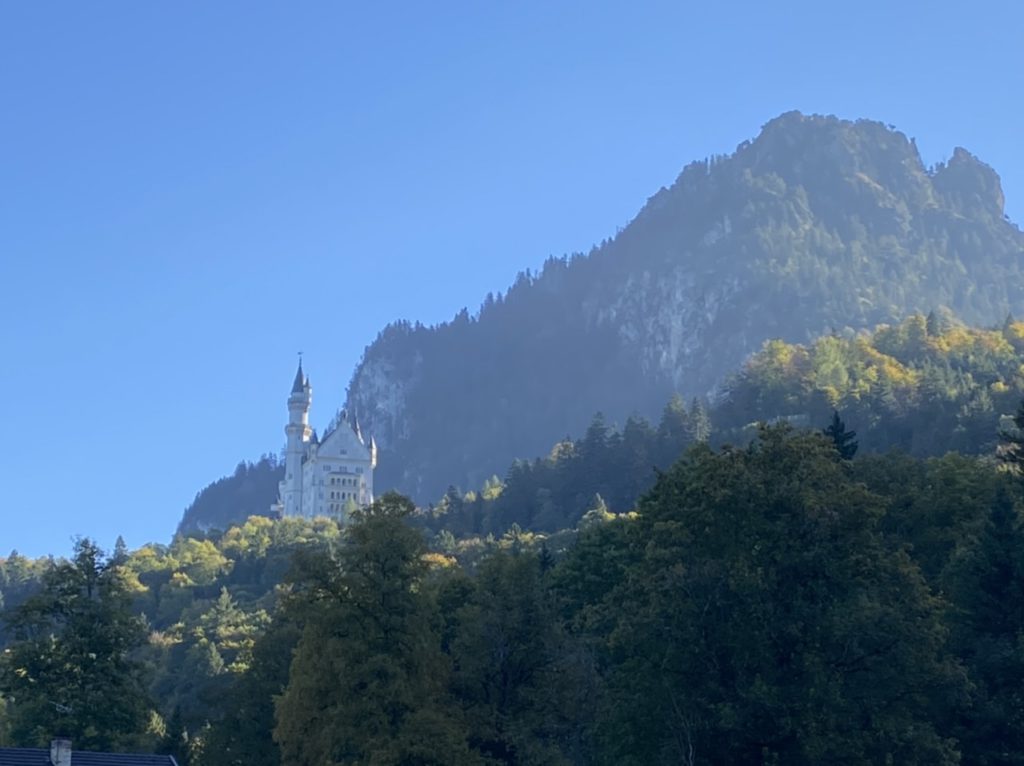
Yes, the castle that inspired Walt Disney’s Sleeping Beauty castle, built by King Ludwig himself. Not far away stands Schloss Hohenschwangau, where Ludwig grew up as a child.
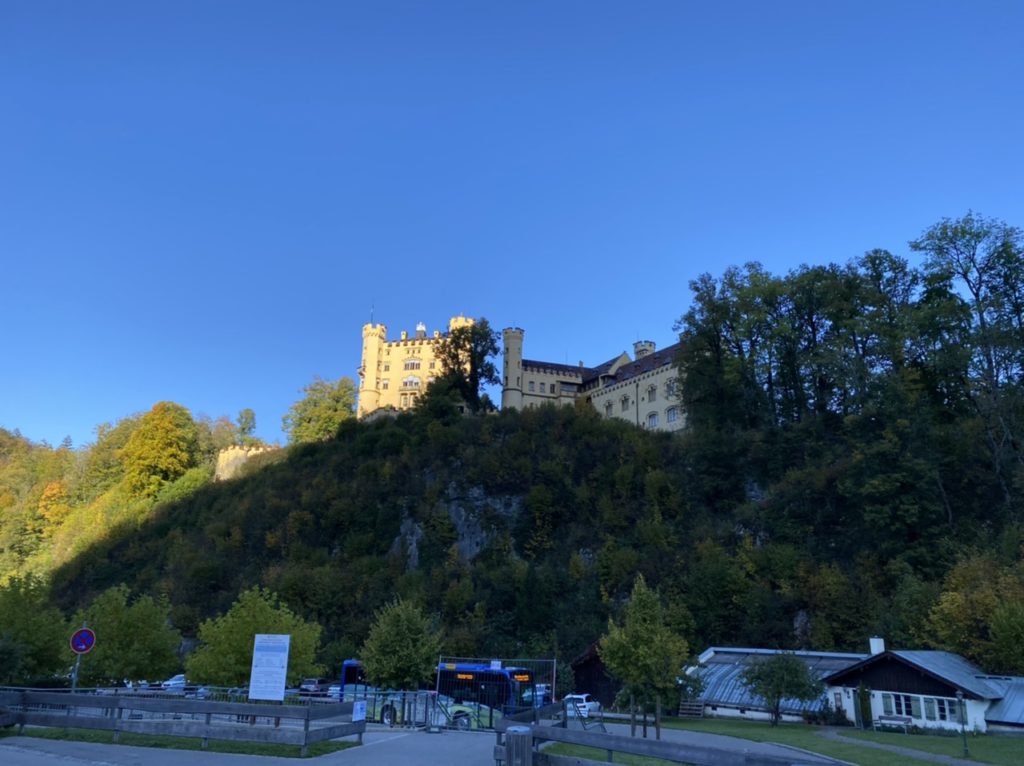
We had several hours until our scheduled tour of Neuschwanstein, so we decided to go for a hike around the nearby Alpsee.
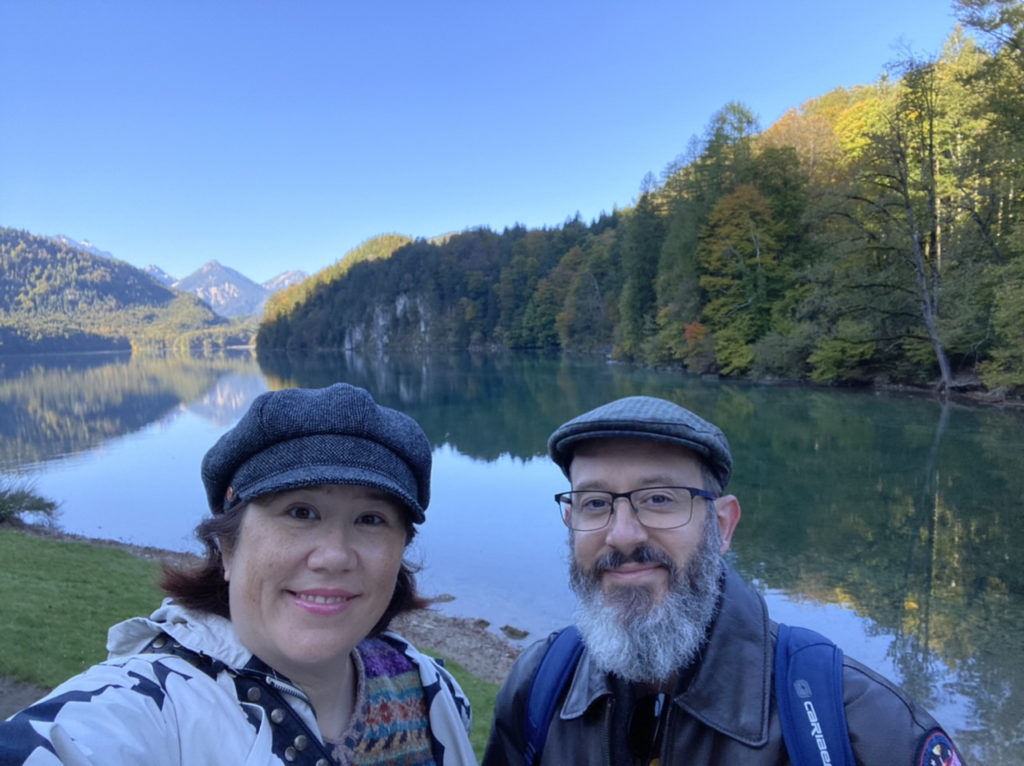
It was a pretty long walk – around 5km all around. Most of it had a well-maintained path and we saw a few families along the way.
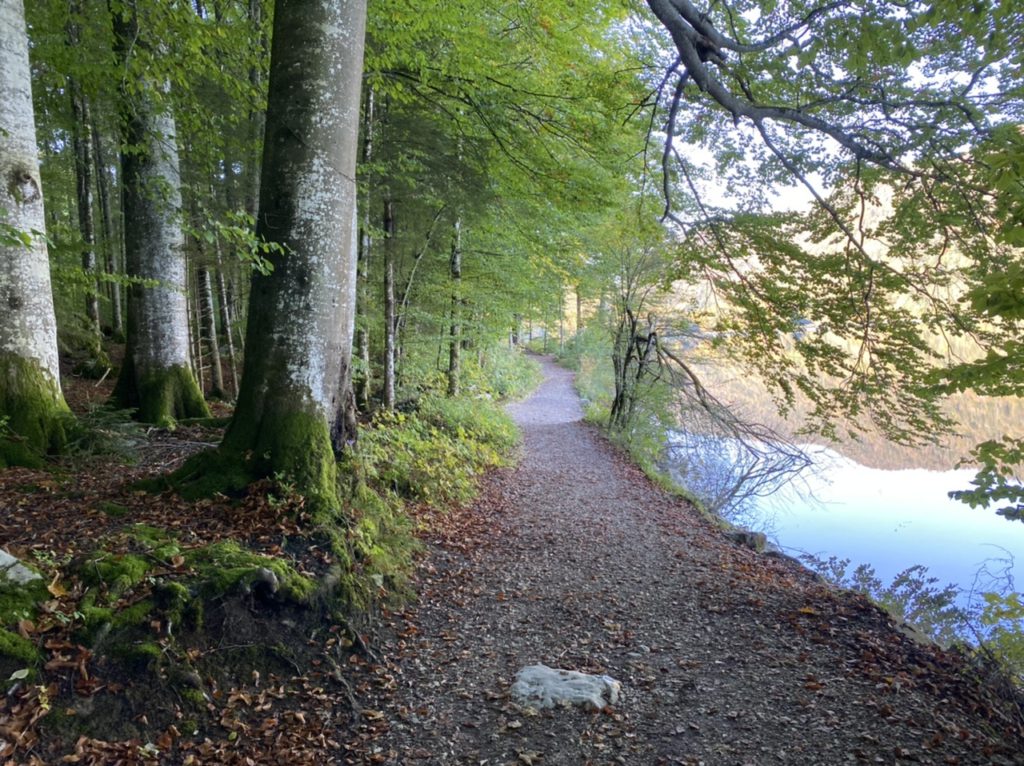
We had lovely views back towards the castles. The sun hadn’t even cleared the sides of the valley yet.

The far end of the lake was marshier, and we had to cross several streams and muddy areas. There were helpful bridges and walkways in places to help us get across.
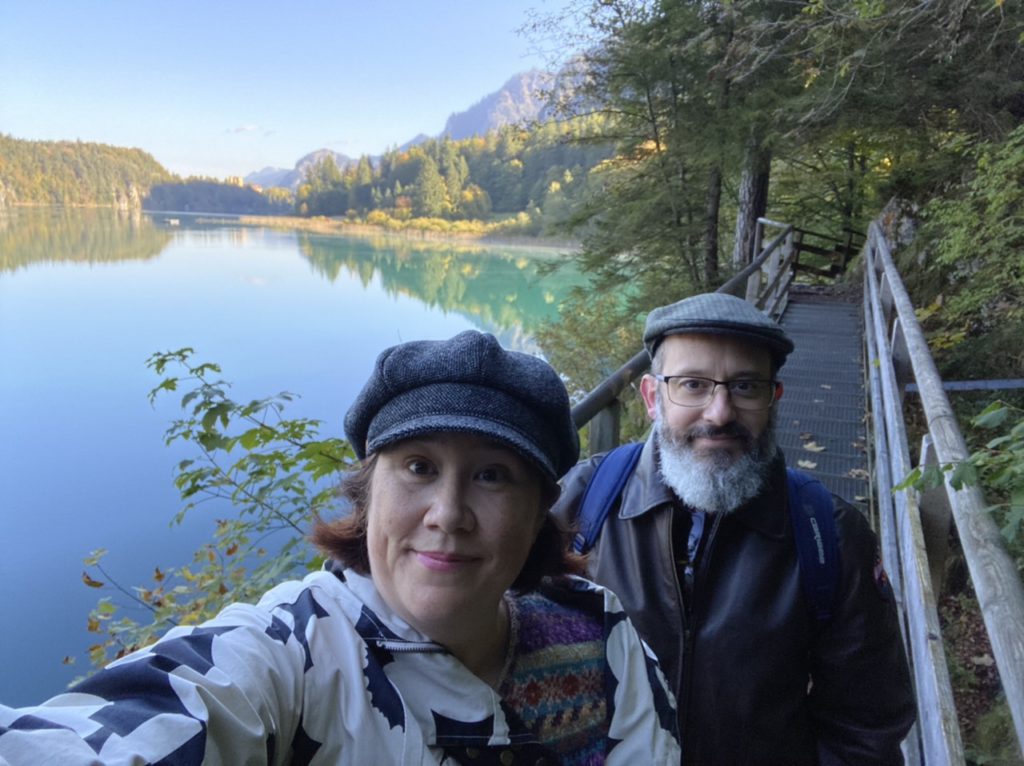
By now the sun had hit the valley, and the hike was getting a little more challenging.
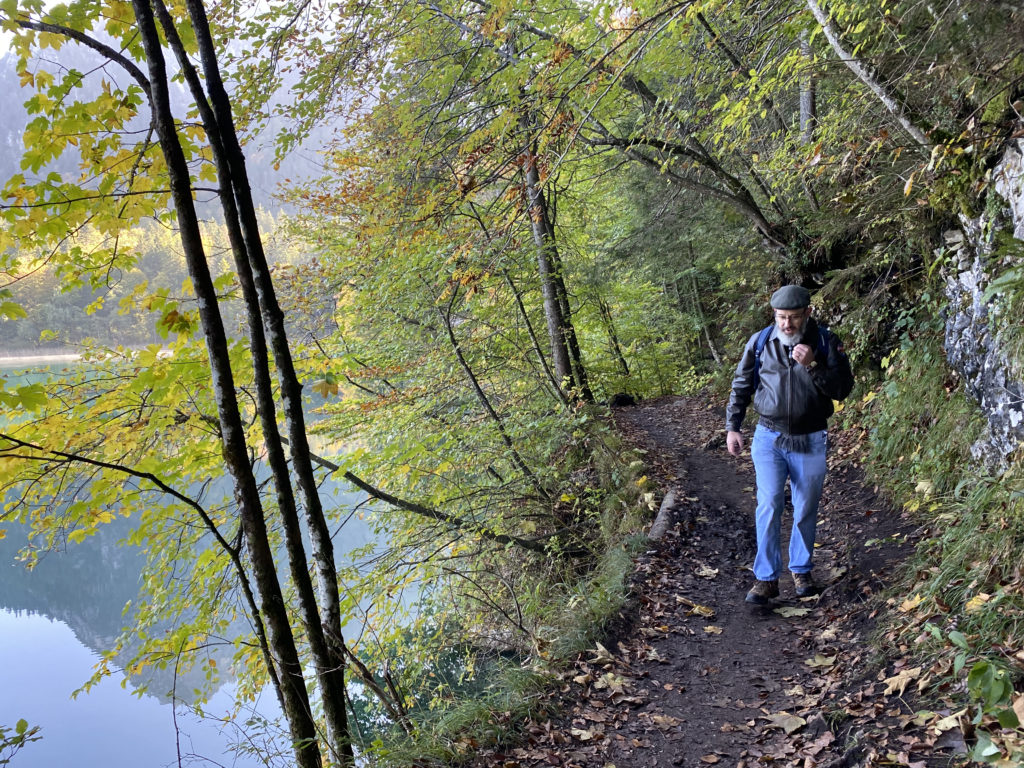
We saw a lot fewer people on this section of the path.
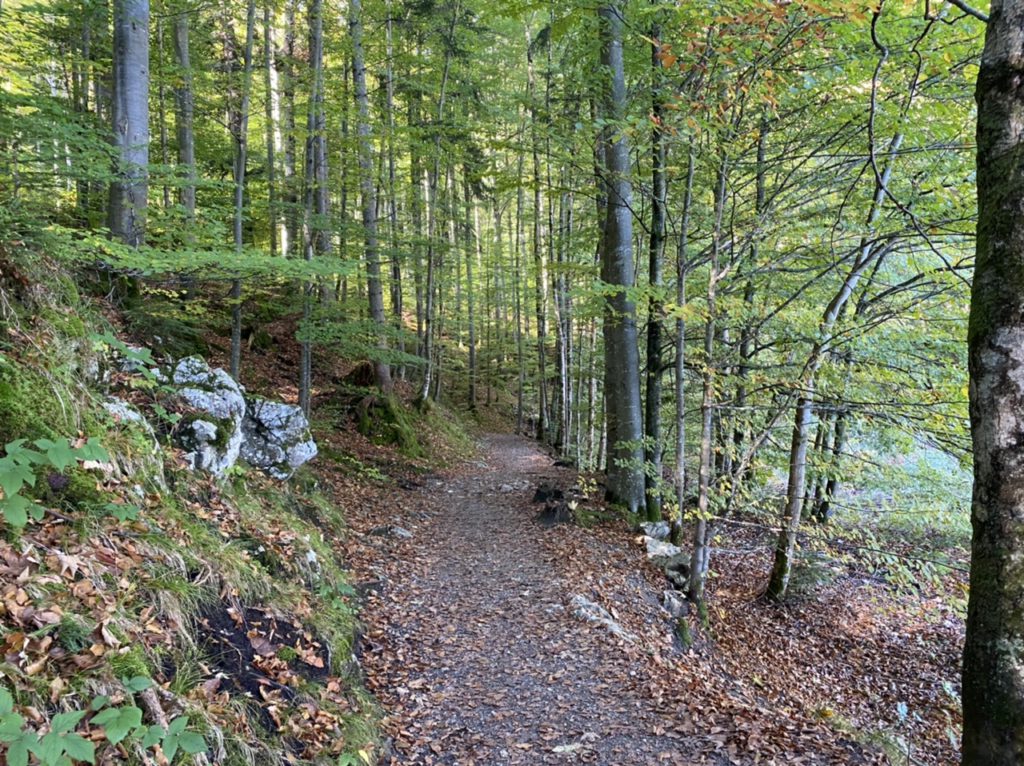
We now had views of Neuschwanstein far off in the distance.

We came upon the special monument King Ludwig built for his mother Marie of Bavaria on the lake.

One last photo from our lake hike… We were getting pretty warm now!
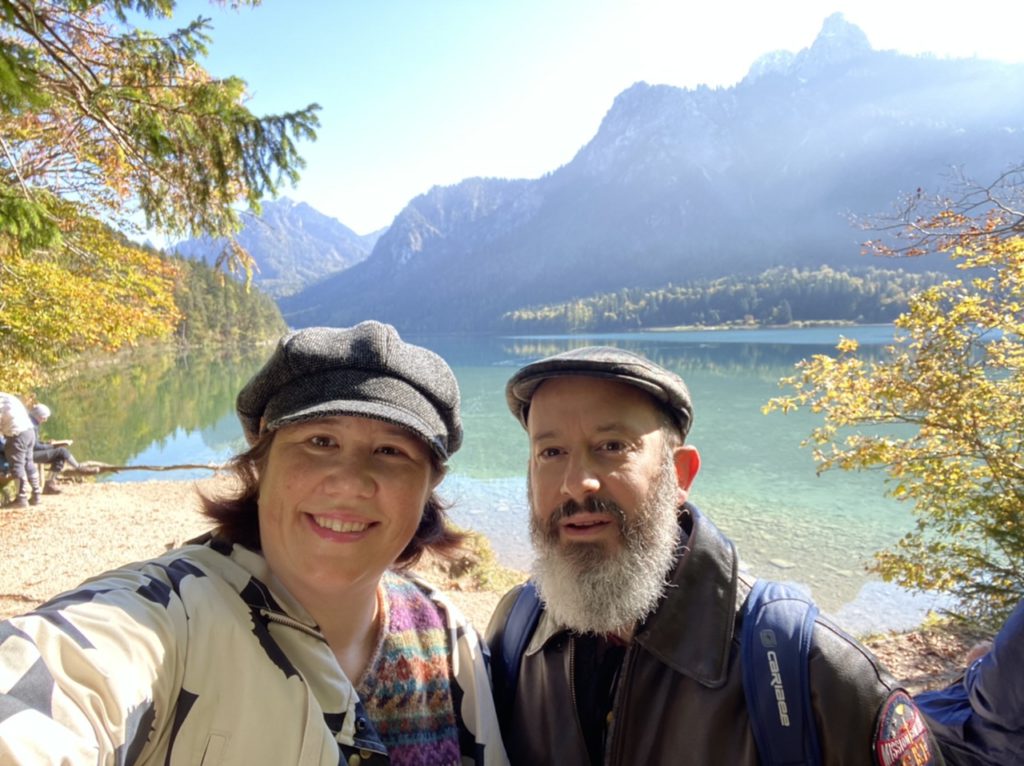
And then it was time to head to Neuschwanstein! You can pay to take a carriage ride up the mountain, but we decided to walk it. You can see the moment about halfway up when I realised “I’ve made a huge mistake.”
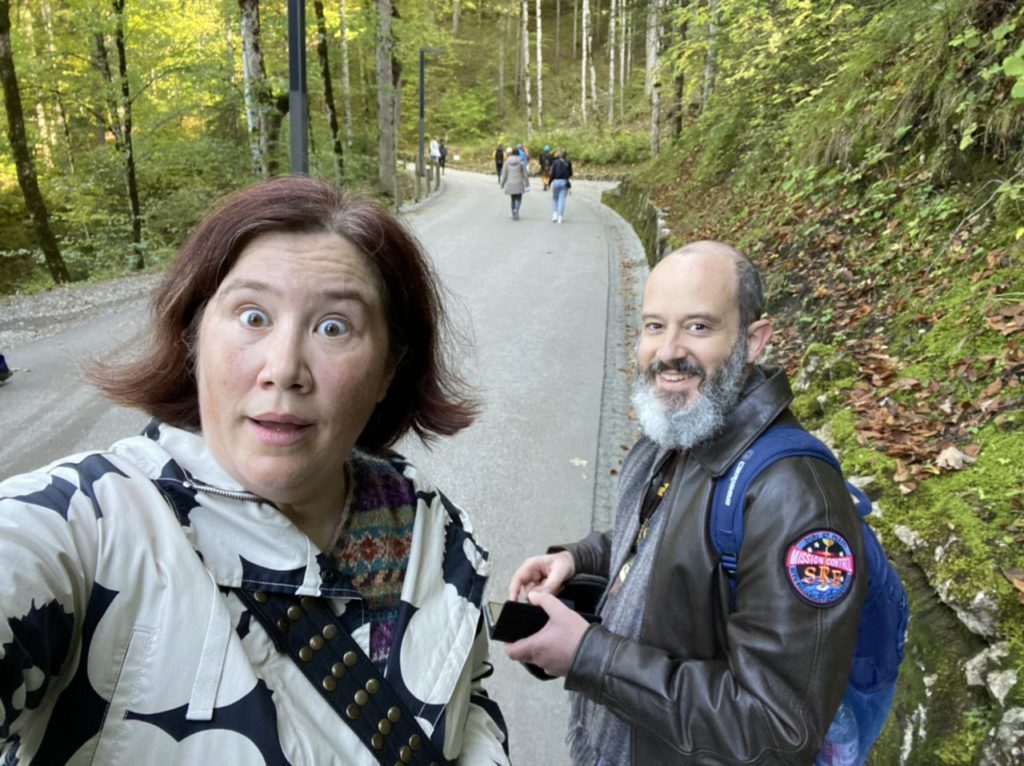
Yeah, it was a pretty steep walk. On the plus side, you get a great view of the castle from below.

There’s a restaurant halfway up if you need a break.

Just slightly below the castle is a big plaza where the horse carriages drop off. There’s also a food kiosk and lockers for you to put your bags. It has some pretty stunning views down across the valley too.
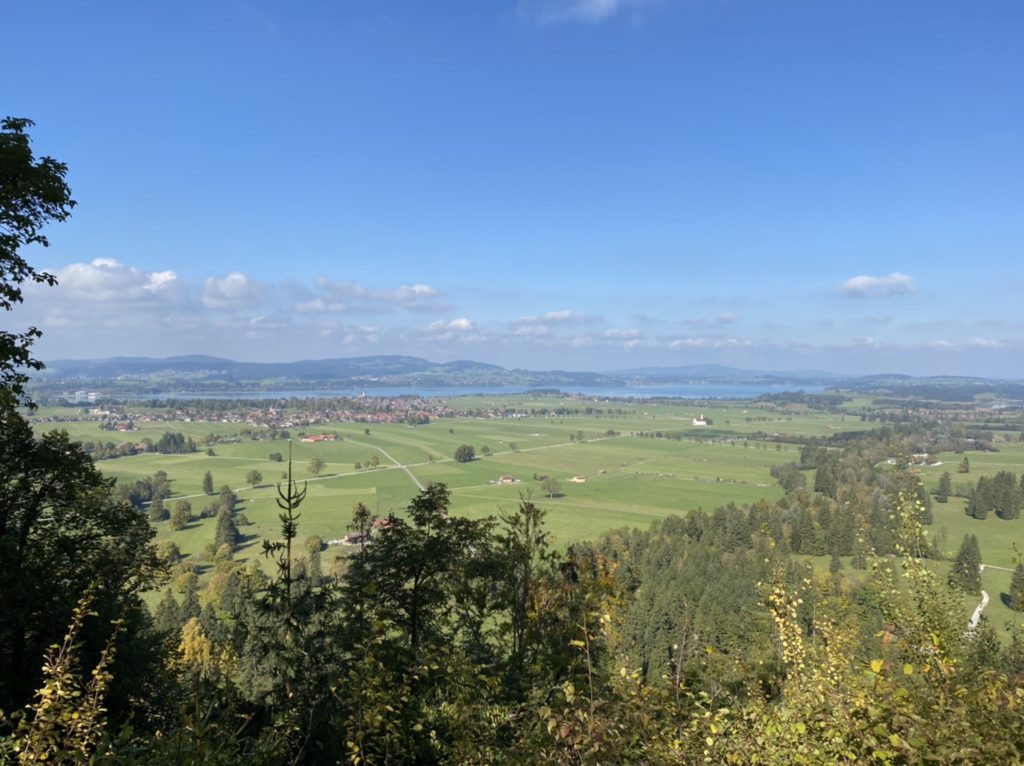
You also get another cool view of the castle.

This is probably a good time to mention that Neuschwanstein is actually not that old. King Ludwig started building it around the time of the American Civil War, and it’s only like 150 years old. The thing is essentially a Victorian folly, a fairytale extravagance inspired by his childhood growing up nearby and his love of Richard Wagner’s operas. Much like Ludwig’s Herrenchiemsee palace (which we also visited), it was stupidly expensive and he barely even got to live in it.

Pro tip: The only way to get inside Neuschwanstein is to book a timed tour, and you have to do that through the website or at the visitor’s center at the bottom of the mountain. I think a lot of tourists missed that memo though, because a security guard at the entrance kept having to repeat it over and over to disappointed people. Thankfully, we were able to show our tickets and Covid passes and gain entry into the inner courtyard.
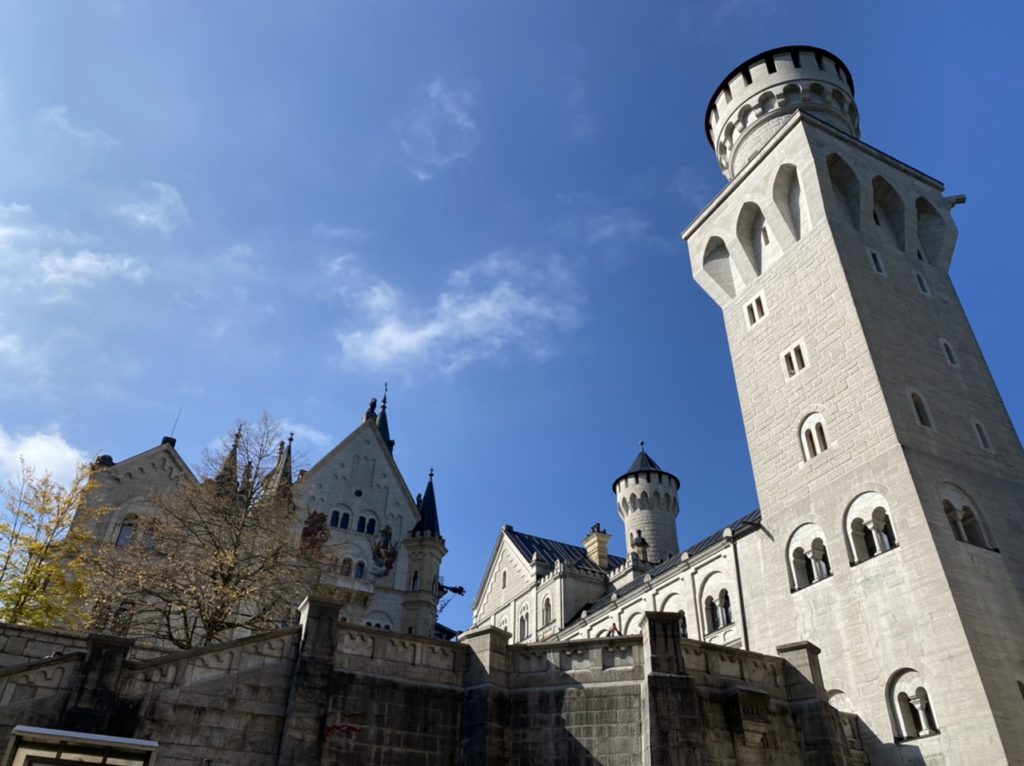
We still had a few minutes before our tour started. From the courtyard you get a good view of the famous Marienbrücke (“Queen Marie’s Bridge”) across a nearby gorge, which apparently offers beautiful views of the castle. Unfortunately it was closed for maintenance so we didn’t bother hiking over there.
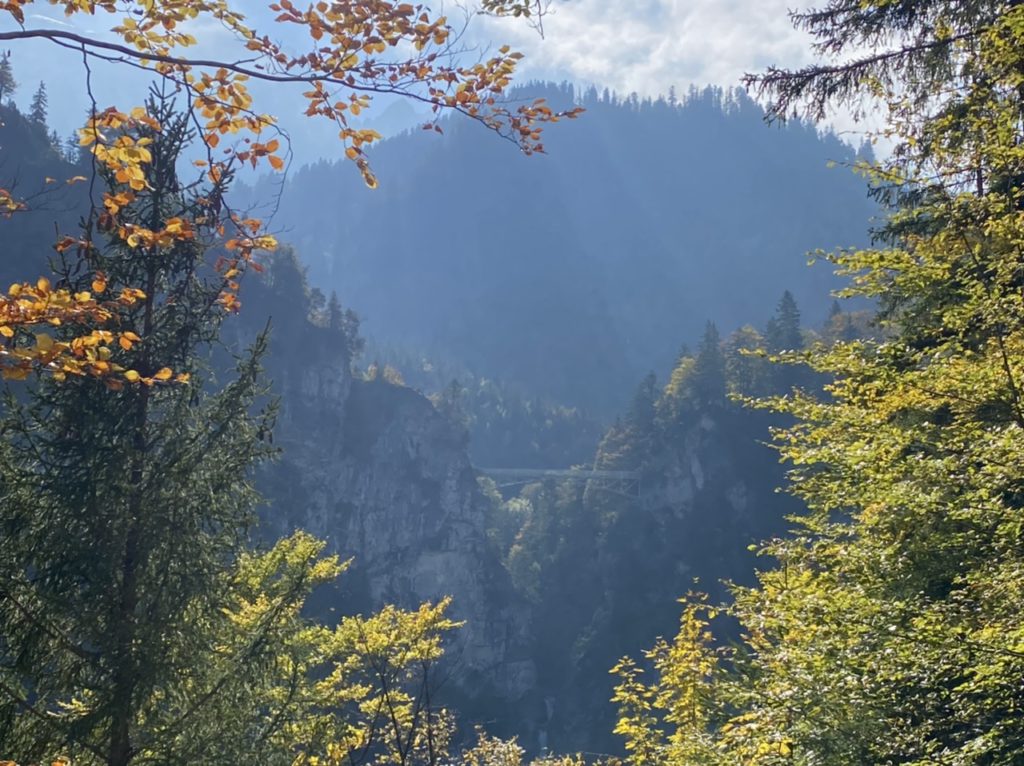
They offer tours in many languages, and we were in an English language group. There were less than 10 people in our group, but pre-Covid they were taking through groups of 60 every five minutes! The tour itself doesn’t allow for photographs, sadly, but you can see pictures on the official website. Several of the rooms (including the throne room) were undergoing renovation so we didn’t quite get to see them in their full splendour. My favourites were the weird Grotto (which reminded me of the Hattifatteners’ cave at Moominworld) and the Singers’ Hall, which was clearly designed just so Ludwig could throw epic parties with all his flamboyant opera friends.
At the end of the tour, just before you get to the gift shop, there’s a balcony you can step out on that offers a view back towards the Alpsee. And yay, photography is allowed! Hard to believe just a few short hours before we had been at the far end of that lake. (Honestly, look at that view. It looks like a painting, but it’s real. I see why Ludwig wanted to live there.)

After picking up a few souvenirs in the gift shop, it was time to begin the long trek back down the mountain. Thankfully going down is a lot easier than going up!
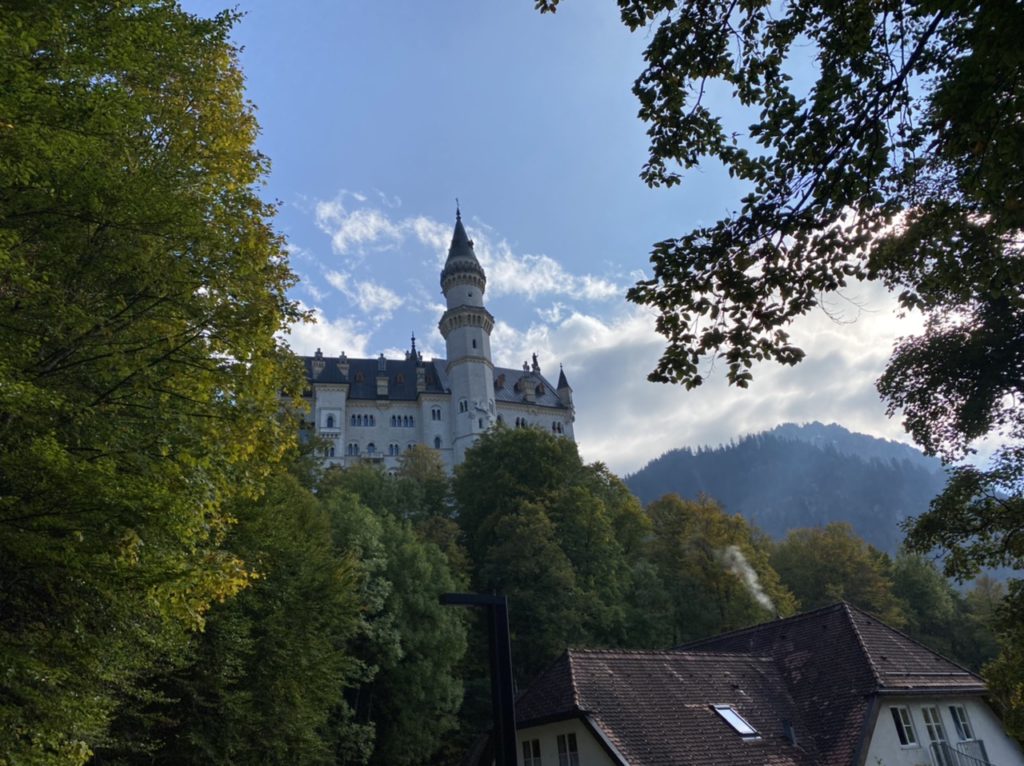
We figured as long as we were in the area, we might as well see where Ludwig grew up too. So the next morning we caught the bus back over so we could visit Hohenschwangau Castle.
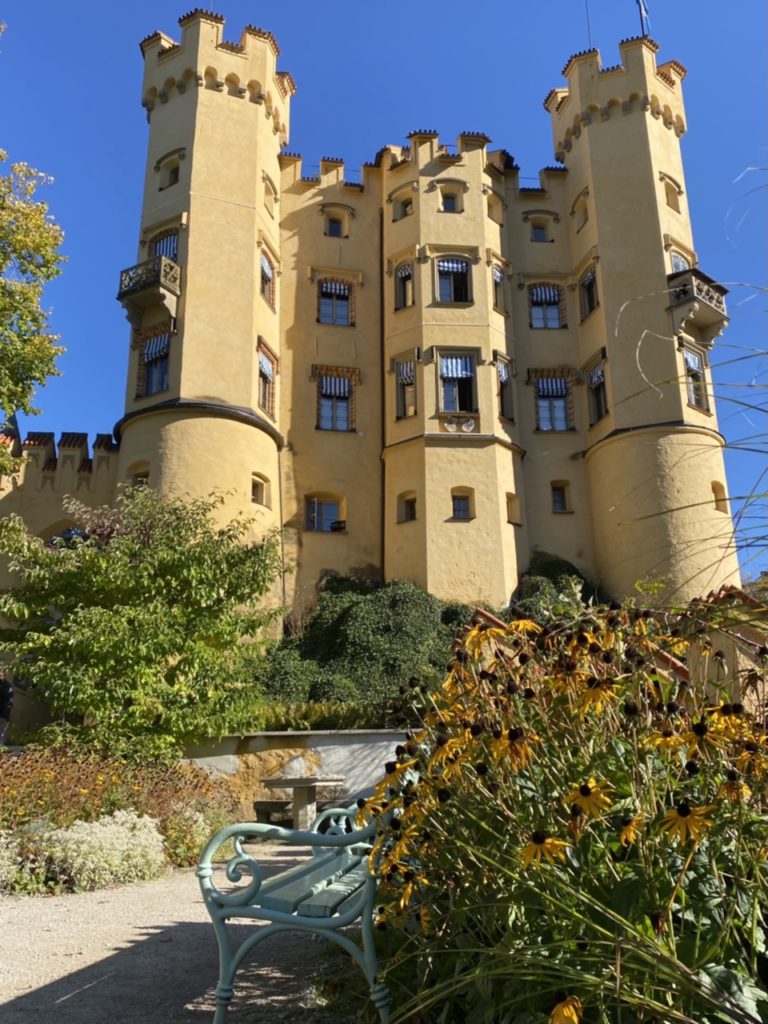
This is also a 19th century castle, but it’s built on the ruins of a much older fortress and thus doesn’t look quite so much like an opera set. King Maximilian II restored the place and lived there with Queen Marie and their sons Ludwig and Otto. We explored the formal gardens outside while we waited for our tour time.

“Schwangau” means “Swan district,” and swans feature heavily in the imagery of both this castle and the nearby Neuschwanstein (“New swan stone”). They both also feature art inspired by the Wagner operas Parsifal and Lohengrin (both incorporating the medieval Swan Knight legend).
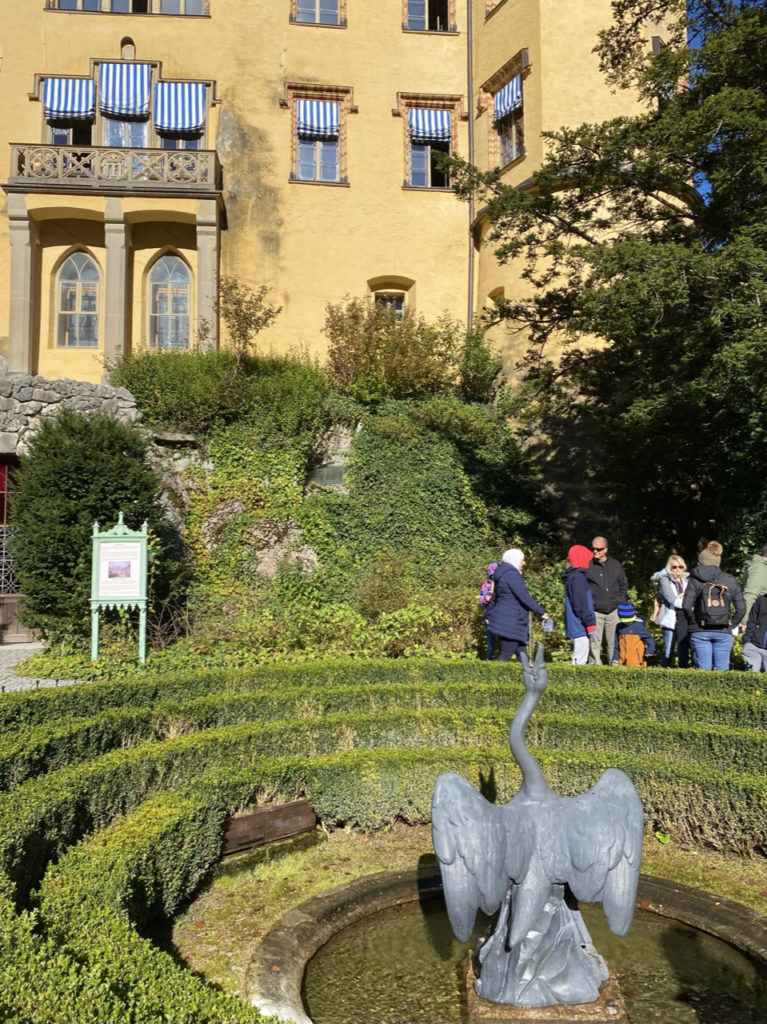
I suspect not as many tourists visit this castle as Neuschwanstein, despite it being right next door. It feels much more like a place where people actually lived, as opposed to a giant fairytale dollhouse.

This tour is also guided, but instead of having separate tours per language you get a little audio device that has information in lots of different languages. Still no photography, but they did tell us we could take pictures of the view out the window. 😍
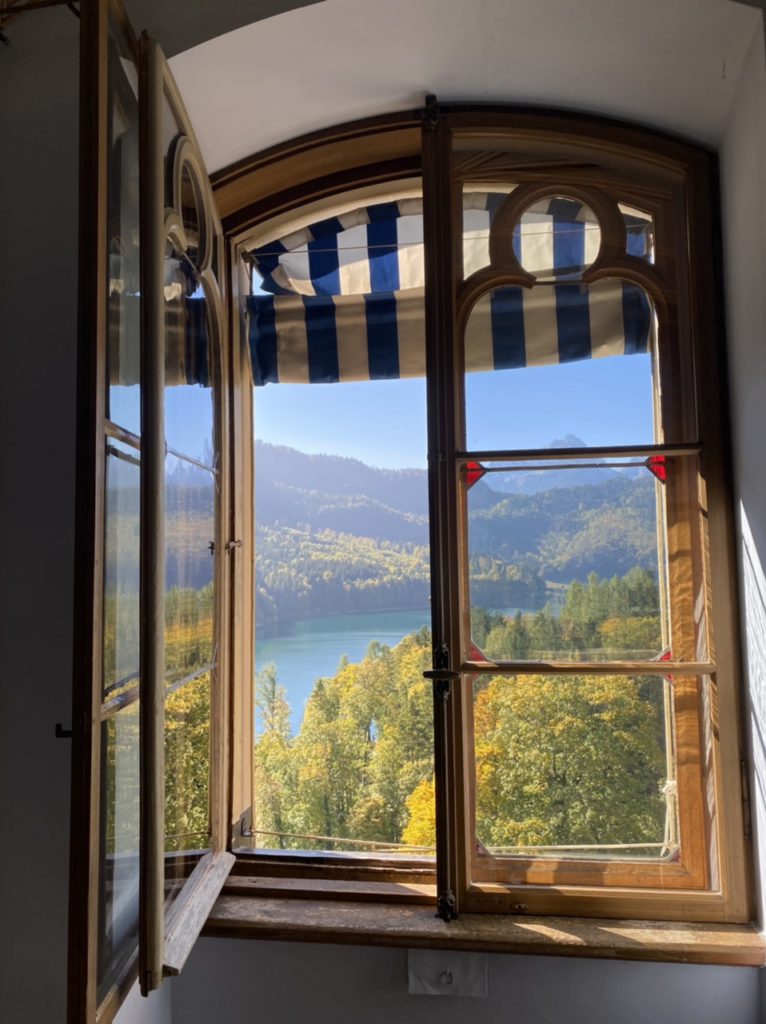
We didn’t have much time left in Füssen so we headed back to town for a final meander. I really love the beautifully decorated and painted buildings.
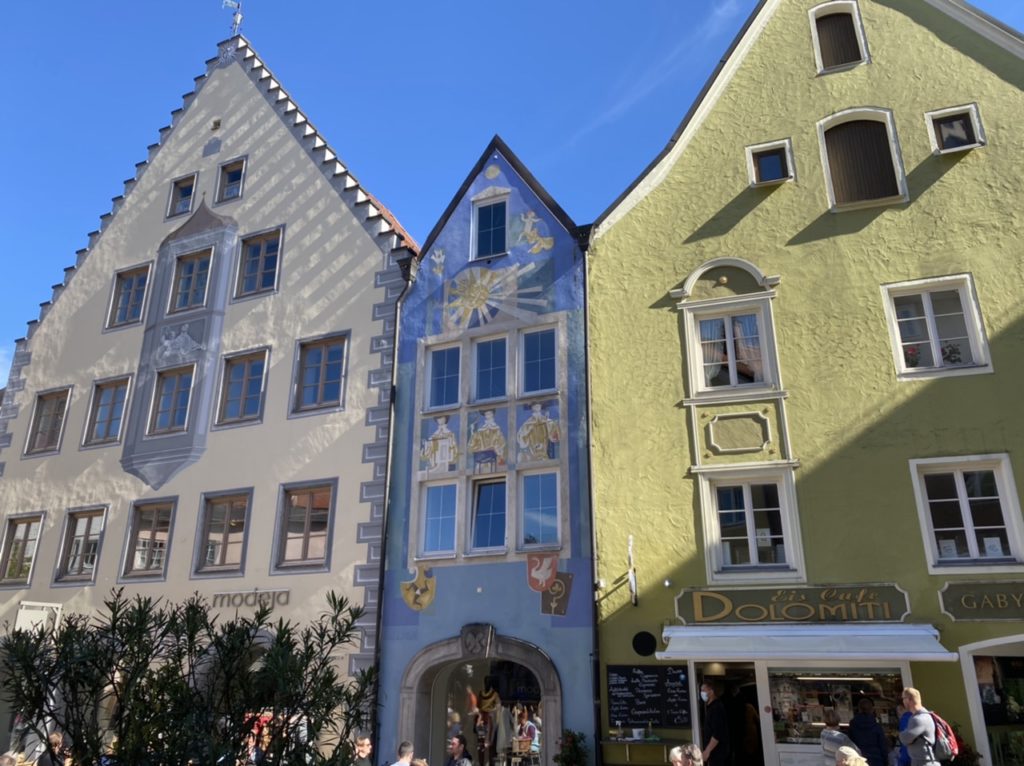
We especially wanted to see the Totentanz (“Dance of Death”) in the St. Anna Chapel at St. Mang’s. This is the oldest preserved such painting in Germany, dating from 1602. The text at the top says, “Says yes; Says no; Must be danced” and beneath are 20 panels showing the hierarchy of 17th-century society starting from the Pope, each dancing away with the personification of Death.

We also had a quick visit to the Museum of Füssen, but there’s so much there and we barely scratched the surface! I really enjoyed the special exhibit on Bavarian Tracht (folk costumes) and the local associations that still celebrate it. I think most non-Germans just think of lederhosen, but actually every little village and region has their own special signifiers from the bristles on the hat down the buckles on the shoes.
The Museum also has the most amazing library, a Baroque explosion that looks like the real-life version of the one from Beauty and the Beast.
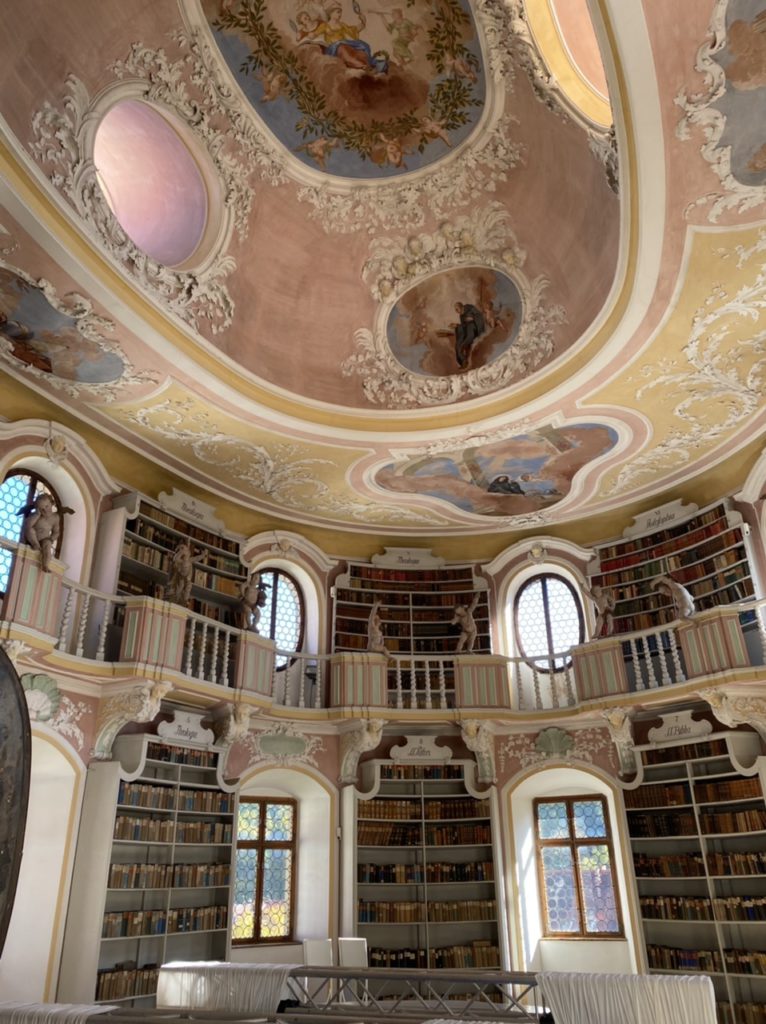
It was almost time to leave, but I can never resist the opportunity for a silly tourist photo.

And that’s it for our weekend of glorious fairytale castles in Füssen!



